Heading out the door? Read this article on the new Outside+ app available now on iOS devices for members! Download the app.
Pregnancy, labor, and delivery are some of the biggest challenges a woman’s body faces in her lifetime, but a strong, supple pelvic floor can minimize many of the discomforts of pregnancy and make delivery easier. Most women know that pelvic floor strength is important, but many of us are unaware that these muscles (even yogis’) are not only weak but tight. And it’s essential to address the tightness of the muscles before attempting to strengthen them.
Tight pelvic floor muscles are usually a symptom of a lack of deep breathing. When we don’t breathe fully, the pelvic floor doesn’t stretch. It stays in it’s shortened, contracted state. Over time the muscles become more rigid, making it more difficult to lengthen without a concerted effort. And since the pelvic floor is the matrix that supports our vital organs, we want it to be as strong and long as possible. Not to mention, its strength and elasticity also plays a big role in a woman’s ability to orgasm. It’s an important network of muscles!
Like most women, during my three pregnancies, I was told to “do my kegels” to strengthen my pelvic floor, that it was just using the muscles that “stop the flow of urine.” My religious practice of kegels never stopped the flow of urine, though, while I was pregnant—or after. As a matter of fact, I always needed to carry extra clothes with me in case I sneezed or laughed too hard. It wasn’t until after my third baby that I learned the actions a kegel was meant to do!
The combination of length and strength in the pelvic floor creates muscles with great integrity to support a baby in addition to all of the organs that rest on it. These strong muscles in conjunction with the gluteus medius are called upon during the second stage of labor (pushing) and are responsible for helping the bones of the pelvis come back together after delivery. Use the following poses to develop the strength and flexibility of these muscles and leave mama with a healthy and happy pelvis!
10 Steps to a Strong, Supple Pelvic Floor
Lengthen: Breathing into the side ribs

This full-breathing practice stretches the diaphragm and pelvic floor.
Focus your breath into the side ribs as you inhale fully. Visualize of gills on a fish expanding out to the sides. As you inhale, the diaphragm and the pelvic floor are stretching. As you exhale completely, feel the ribs come back to center and the pelvic floor subtly lift. Continue for 8–10 breaths.
See also Core Concept: Soften Your Middle for a Stronger Core
Lengthen: Supta Baddha Konasana

There is a close relationship between the hip adductors (inner thighs) and the pelvic floor muscles; tight adductors make the pelvic floor muscles far less elastic. Tight adductors also make hip abductors (e.g., gluteus medius) weak. So we can also affect the length of the pelvic floor muscles by stretching the inner thighs in well-supported postures.
Come into Supta Baddha Konasana with blocks beneath the outer thighs to support the opening of the inner thighs. Relax here for a few breaths, then continue to next step.
See also Q+A: Grace Flowers on Pregnancy + Living Wholeheartedly
Strengthen + Lengthen: Kegels in Supta Baddha Konasana

Practicing a kegel properly is the best way to get the muscles of the pelvic floor to draw toward one another, stretching and lengthening them. Once the muscles are well connected, you recruit transverse abdominis to draw everything in and up, similar to mula bandha, but with a real connection of the pelvic floor.
Still in Supta Baddha Konasana, picture the pelvic floor muscles between your two sitting bones. Inhale, and as you exhale, draw the muscles together as if they were the two halves of an elevator door closing to meet in the middle. Once this door is closed, lift the elevator up and then release. Next, imagine the pelvic floor muscles between your pubic bone and tailbone. Inhale, and as you exhale, draw those muscles together in the same elevator-door fashion, lift the elevator, and then release. Now, draw all four elevator doors together at once, meeting at one point in the middle, then lift, hold for up to 8 breaths, and release. Repeat 5 times, and rest. Aim to repeat this Kegel practice 2 to 3 times a week.
See also New Study Finds More Yoga Poses Safe During Pregnancy
Strengthen: Clam Shell Leg Lifts
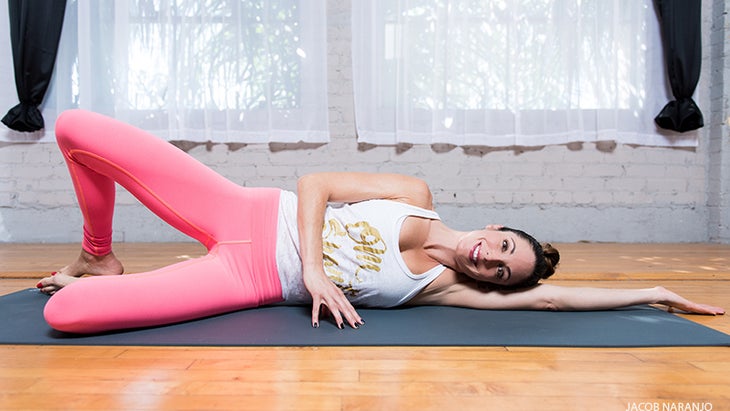
The strength of the gluteus medius muscle plays an integral role in pelvic stability that directly affects the engagement potential of the pelvic floor. I like to wake up the gluteus medius through a series of side-lying leg lifts.
Lying on your side, bend your knees so your thighs are at a 45-degree angle to your torso. Keeping your heels together, inhale to open your knees as wide as possible without allowing your pelvis to roll back. Exhale to come back to center. Repeat for 30 breaths.
See also The Benefits of Prenatal Yoga
Strengthen: Side-Lying Leg lift
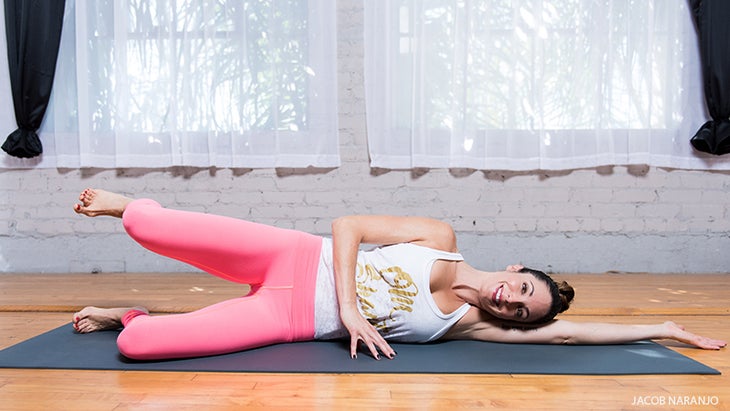
Lying on your side, bend your knees so your thighs are at a 45-degree angle to your torso. This time keep your ankle in line with your knee and lift the leg as high as you can maintaining pelvic stability, as you inhale. Exhale back to start. Repeat for 30 breaths.
See also The Guide to Prenatal Yoga: Everything You Need To Know
Strengthen: Side-Lying Rotation Lift
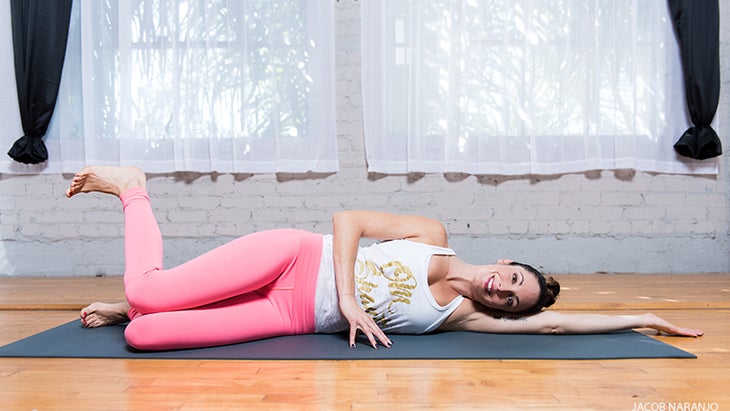
Lying on your side, bend your knees so your thighs are at a 45-degree angle to your torso. Lift your top leg as high as possible, maintaining pelvic stability. Keeping the ankle at this height, rotate the femur in the hip socket, as you inhale, to tap the top knee to the bottom knee. Exhale back to start. Repeat for 30 breaths.
See also Yoga for Moms: Healing Your Pelvic Floor
Lengthen: Side Lunge
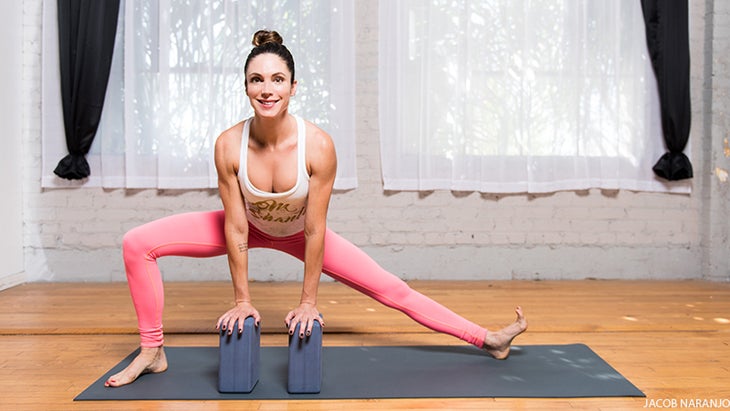
This lunge opens the inner thighs, which helps lengthen the pelvic floor.
Have two blocks handy. Stand with your feet about a leg’s length apart. Maintaining the connection of both heels to the floor, bend into one knee. Bring your hands to the earth or to blocks. Keep the other leg straight and externally rotate the straight leg from deep in the hip socket so the toes point to the ceiling. Hold for 5 breaths then switch sides. Repeat once more per side.
See also Build Supple Strength in the Pelvic Floor
Strengthen: Virabhadrasana II
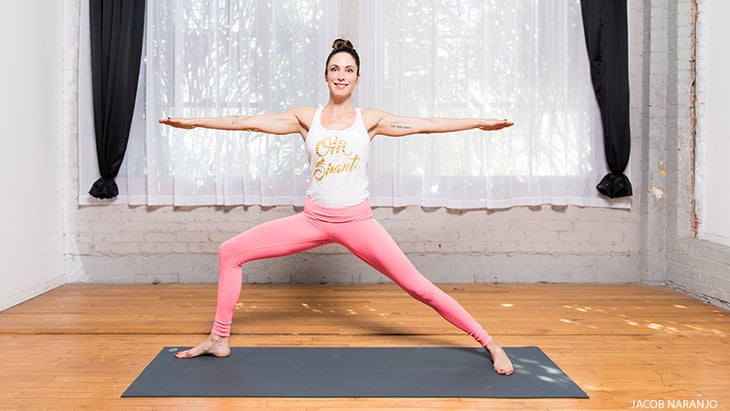
Externally rotated yoga postures like these next three strengthen the gluteus medius muscles, which are key for delivery and pelvic floor support.
From Downward-Facing Dog, step the right foot forward and spin the back heel down. Check to see that your feet are aligned heel to heel. Bend the front knee so the front thigh is as close to parallel with the earth as possible in your body. Straighten the back leg. Square your torso, but not the pelvis to the side of your mat, as you extend the arms out straight to the side, keeping the wrists at shoulder height.
Making sure the front knee stays in line with the second and third toes, feel all of the muscles of the front outer hip and thigh wrap earthward as you hug the whole thigh toward the center of your body. This is the work that builds strength and endurance in the outer hip muscles, especially gluteus medius. Keeping the back foot slightly angled toward the front corner of the mat, press the top of the thigh straight back. Hold for 10 breaths.
See also Glute Anatomy to Improve Your Yoga Practice
Strengthen: Trikonasana

From Virabhadrasana II, draw the front leg to straight. Allow your pelvis to tip over the front thigh as you reach forward, lengthening the sides of the body as much as possible and then release the hand to your shin, the earth, or a block to the outside of the front leg. All of the same actions from Virabhadrasana II apply here. Continue to feel all of the muscles of the front outer thigh and hip wrap back and hug the thigh to center. Keep pressing the top thigh of the back leg straight back. Hold for 10 breaths.
See also Yoga for Moms: Re-establishing Your Connection to Your Core
Strengthen: Ardha Chandrasana
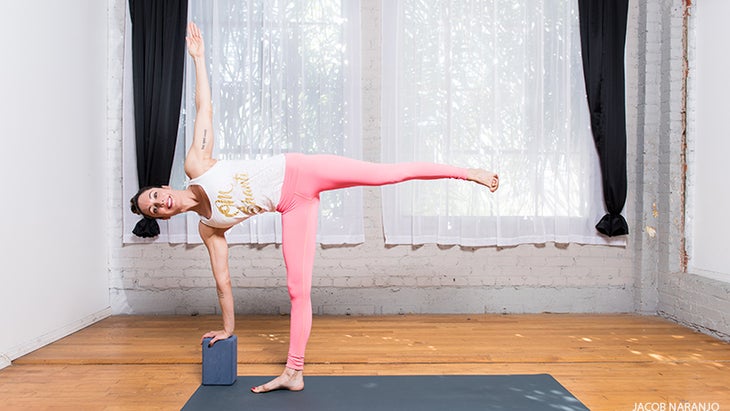
From Trikonasana, bring your top hand to your hip. Turn to look at the toes of your front foot. Bending your front knee, shift your bottom hand forward as you lift your back leg up. Straighten both legs. Like in the previous two poses, wrap all of the muscles of the standing leg’s outer thigh and hip back and hug the thigh to center. Bring the lifted leg to hip height, slightly in front of the hip. From deep in the hip socket, allow the inner thigh to roll back so the toes point a bit earthward. Hold for 10 breaths.
See also 12-Minute Core Strength Sequence (for Real People)
ABOUT OUR EXPERT

Los Angeles-based yoga teacher Karly Treacy began her practice more than 20 years ago. A student of Annie Carpenter, Karly understands the awareness of body and strength that comes from precise alignment. A mother of three, Karly credits yoga for teaching her that all of life is a practice, especially motherhood and that our children, our bodies, and our environment all are our teachers. Follow her on Twitter @karlytreacyyoga and Facebook @karly.treacy